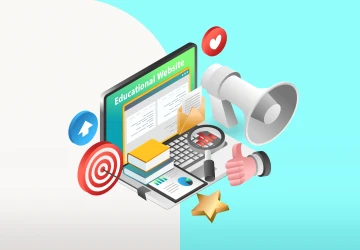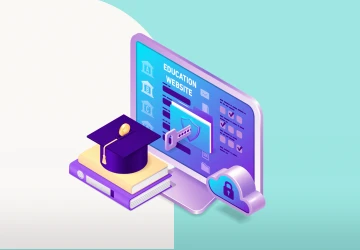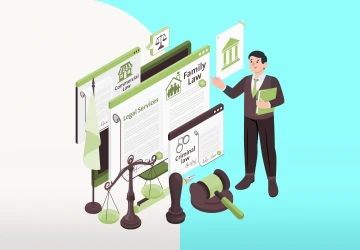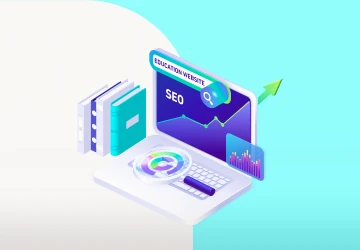Why Schools Need Websites: The Secret to Staying Connected

These days, pretty much every business or organization has a website—from small shops to big hospitals.
So it only makes sense for schools to have one too.
A strong school website design isn’t just about looking good—it’s how you build a clear school presence, stay connected with families, and show what your school is all about.
It’s also the perfect place to share updates, highlight what makes your school special, and give access to helpful online education tools.
In this guide, I’ll walk you through why your school needs a website—and how to make it work for you.
Why Does Your School Need a Website?
1. Simplify Online Admissions Processes
A great school website design isn't just about looking nice—it can also simplify the admissions process.
At the start of a new school year, your team probably gets flooded with paperwork, forms, and endless phone calls.
But with a good website, all of that can go digital.
With everything clearly laid out on your website, parents and students can quickly find exactly what they need—like how to apply, deadlines to remember, and the documents required.
No more digging through piles of paperwork or feeling confused about the next steps.
It's easier for everyone involved, right from the start.
2. Improve Communication Between Teachers and Students
Another big reason to invest in school website design is to improve how teachers and students communicate.
Instead of relying on paper handouts, last-minute emails, or classroom announcements that can easily get missed, a website brings everything together in one place.
Teachers can use the site to post important updates, class schedules, or reminders about assignments.
They can even upload helpful materials like lecture notes, slides, or extra resources for students who need a bit more support.
You can also integrate online education tools like discussion boards, chat rooms, or contact forms—making it easy for students to ask questions, get feedback, or share ideas.
3. Offer Advanced Digital Education Resources
Since COVID-19, online education tools have become a big part of how students learn—both in the classroom and at home.
These days, families expect schools to be flexible and tech-friendly, and a strong school website design makes that possible.
Your website can act like a digital home base where students and teachers find everything they need.
With tools like Google Classroom and school accounts, it's easier to organize online classes, share resources, and keep everyone on the same page.
Students can easily access lessons, homework, class links, and extra materials—all in one place, with less stress and confusion.
And for parents, it’s a clear sign that your school is keeping up with the times, using tech that supports learning and builds a more connected school presence.
4. Strengthen Community Connections
Having a solid school website design does more than just share info—it helps your school feel like a real part of the online community.
While social media can help you reach some people, it’s limited.
A website gives you a full digital presence that you completely control.
Your site becomes a place where people can truly get to know your school—what you stand for, what makes you special, and how you support your students and families.
It also helps your school reach beyond the local area.
In today’s world, people from anywhere can learn about your school just by visiting your site.
5. Boost Your School’s Brand Identity
Every school has its vibe—its values, goals, and what makes it special.
A good school website design is one of the easiest ways to show that off and make your school stand out.
Your website is the perfect place to bring your brand to life.
You can show your school’s logo, colors, and slogan, and create a look and feel that people will remember.
It’s not just about having a nice design—it’s about helping families, students, and staff connect with who you are.
Plus, your website makes it easy to share that identity with a wider audience.
6. Build Credibility and Trust
Nowadays, people expect pretty much every place—including schools—to have a website.
If your school doesn't have one, families might wonder why.
Having a good, clear website helps build trust right from the start.
For example, imagine a parent checking out different schools online.
If your website is clean, professional, and easy to use, they'll feel confident that your school is organized and dependable.
But if your site is messy, outdated, or confusing, they might assume your school isn't very well-run or doesn't pay attention to details.
Your website is often the first impression families get—so a thoughtful, appealing design can make a huge difference in attracting new students and building trust from day one.
If you're looking for an easy way to create your school website, tools like Alweb.ai can help you set things up quickly and smoothly.
7. Stand Out from Competitors
Let’s face it—families today have options.
When they start looking for a school, the first thing they’ll often do is check out a few websites.
That’s where your school website design can help you stand out.
A great website lets you show off everything that makes your school special.
Maybe you have a top-notch music program, a robotics club that’s won awards, or a strong focus on bilingual education.
Your site is the perfect place to share those stories.
You can include student success highlights, like a class that raised money for a community cause, or showcase photos of your science labs, art studios, or playground.
You could even add a calendar with upcoming events, so families can see how active and engaging your school life is.
And unlike flyers or newspaper ads that reach a limited audience, your website can reach people instantly—anytime, from anywhere.
8. Increase Your School’s Visibility Online Through SEO
In today’s world, most parents start looking for schools by typing a few words into a search engine like Google: things like “best high schools in Dallas” or “elementary schools with art programs near me.”
If your website isn’t optimized for these kinds of searches, it might not show up—meaning families could miss your school entirely.
That’s where Search Engine Optimization (SEO) comes in.
SEO is all about tailoring your site so search engines recognize it as relevant and valuable to people’s searches.
For example, if your school specializes in bilingual education, including keywords like “Spanish immersion elementary in New York” in your page titles, headers, or content can help search engines (and parents) find you.
The same goes for any unique aspect of your school: robotics, sports teams, performing arts, or STEM programs.
Beyond just keywords, SEO also involves ensuring your site is easy to navigate, quick to load, and works well on mobile devices—all factors that search engines look for when deciding which sites to rank higher.
If your site meets these standards, it’s more likely to appear near the top of the results.
Why does that matter?
The higher you rank in search results, the more likely parents are to click on your school first—leading to more website traffic, more visibility, and more inquiries about enrollment.
9. Attract and Recruit Qualified Staff
It’s no secret that schools across the country are facing a tough time hiring teachers and support staff.
With tens of thousands of vacancies reported in recent years, it’s more important than ever for schools to stand out to job seekers—and that’s where a strong school website design plays a key role.
Your website isn’t just a place for parents and students—it’s a powerful recruitment tool.
Potential teachers aren’t just looking for job listings.
They’re looking at the full picture: What’s the school culture like? Is it easy to apply? Do they offer any incentives or benefits? How welcoming and accessible does the school seem?
For example, imagine a teacher moving to a new city.
If your homepage has a clear “Careers” section with open roles, application steps, and even a peek into what it’s like to work at your school, you’re making their decision that much easier.
On the other hand, if your job postings are hidden or the application process is confusing, they might move on to another school’s site.
The best part?
You don’t need to do anything fancy.
Just having a dedicated careers page with clear, helpful info—like benefits, school values, community involvement, and support systems—can set you apart.
Highlighting things like mentoring programs for new teachers or professional development opportunities can make a huge difference too.
9. Promote Equity and Inclusivity
Your school website design isn’t just about information and appearance—it plays a big role in how inclusive and accessible your school truly is.
When families, students, or staff visit your site, they should all be able to use it comfortably—no matter what device they’re on, what language they speak, or whether they have a disability.
But many schools are still catching up.
Some websites aren’t optimized for mobile phones, making it tough for users to navigate on smaller screens.
Others aren’t ADA-compliant, meaning they’re hard to use for people with visual impairments or other disabilities.
One school even mentioned that their site was difficult to understand—even for highly educated users.
That’s a missed opportunity.
By improving your website’s accessibility and responsiveness, you’re not just meeting legal requirements—you’re showing every visitor that they matter.
For example, adding screen reader support, clear navigation, and translations for non-English speakers can make a huge difference.
And when you include easy-to-find information about your school’s use of technology and data privacy, families feel more confident and secure.
Let’s say a parent with limited tech access visits your site from a mobile device—they should still be able to easily access enrollment info, class schedules, or contact details.
Or if a student uses assistive tech, your site should work with their tools, not against them.
How Much Does It Cost to Build a Website for a School?
The price of building a school website depends on what you're after.
If you just need the basics—like a homepage, a contact form, a calendar, and some general info for students and parents—you're looking at spending from $3,000 to $15,000.
This covers all the essentials without anything too fancy.
But if you're aiming for something more high-tech, like interactive dashboards, parent portals, or custom profiles for students, then you'll need to budget more—typically between $20,000 and $40,000.
So, we can say that the total price will hinge on a few things: how big your school is, how personalized you want the website to be, and who you hire to build it.
I always recommend chatting with a web development pro to nail down exactly what you need and get a price that fits what you're looking for.
They'll give you a quote that fits your needs and budget, and they can guide you through all your options to ensure you get a website that’s worth the investment.
What Elements Should Be on the School Website?
Your school website acts like an online home for students, parents, and teachers.
So, it’s important to have key features that visitors will find useful.
Here’s a list of essential elements your school website should have:
News and Events Information: Keep everyone updated on what’s happening around your school.
All Activities Schedule: A clear calendar for sports, clubs, events, and other activities.
Parents and Students Reviews: Let visitors see what families and students think about your school.Exams Schedule and Results: Easy access to exam dates, important notices, and results.
Educational Programmes: Showcase the courses, special programs, or unique opportunities your school offers.
Location and Contact Details: Display your address, phone numbers, emails, and directions to your school.
Inquiry Form: A quick and easy form that families can fill out to get answers to their questions.
Admission Form: Allow students and parents to apply directly through the website.
E-books Section: Digital books or resources for students to download and use.
Online Courses Offered: Show any online classes or remote learning options you have.
About School: A page introducing your school’s history, mission, values, and key staff.
Chat Support: Offer immediate help or answers to visitors through live chat.
Privacy Policy: Clearly outline how your school handles personal data, ensuring families feel safe and informed.

Which Are the Best Website Builders for School Websites?
Here are some of the best website builders you can use to create a professional, easy-to-use school website:
Alweb.ai: Uses smart technology to make the design process quick and easy, even if you don't have any technical experience. It provides ready-made templates perfect for schools, ensuring your website looks modern, professional, and engaging.
Weebly: User-friendly and budget-friendly, Weebly offers intuitive drag-and-drop tools and lots of educational-themed templates.
WordPress: Great if you need customization and flexibility. It offers thousands of themes and plugins to help tailor your website exactly how you want it.
Squarespace: Known for elegant, visually appealing templates. Ideal for schools that want a sleek, modern look.
Webflow: Offers advanced design control with a powerful visual builder. Best for schools that want complete freedom to create detailed, interactive designs.
Wix: Popular for ease of use with a drag-and-drop editor, hundreds of templates, and helpful built-in features perfect for school websites.
FAQs
What Is the Purpose of a Classroom Website?
A classroom website keeps students and parents informed, provides resources, and supports learning outside of class. It creates smoother communication between teachers, students, and families.
Why Do We Need to Have a Website?
Having a website helps your school share information easily, boost credibility, and connect better with your community. It makes your school accessible anytime, anywhere.
What Makes the Best School Website?
The best school websites are easy to navigate, clearly organized, and full of useful information for students, parents, and teachers. They’re welcoming, responsive, and user-friendly.
Why Schools Block Websites and You Should Too?
Schools block certain websites to protect students from inappropriate content, distractions, and cyber threats. Doing so keeps students focused, safe, and productive during class hours.
Final Thoughts
As promised, we’ve covered how a strong school website design can simplify admissions, boost communication, showcase online education tools, and strengthen your school's presence.
One specific piece of advice?
Schedule regular website checkups—just like you’d maintain a school building—to keep your site running smoothly and looking fresh.
This ensures your content stays relevant and your audience remains engaged.
Ready to take your school website to the next level?
Reach out today, and let’s work together on building an online presence that truly reflects your school’s values and goals.







